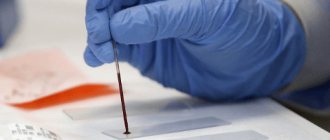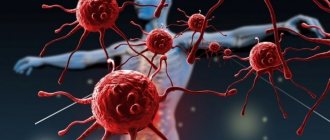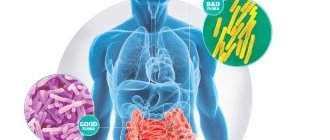Digestive enzymes - what are they?
The popular expression “you are what you eat” really does carry a certain amount of wisdom. But it would be more accurate to say “you are what you digest.” And this is where digestive enzymes, or enzymes, help us, the key to good digestion, a healthy gut and getting all the nutrients you need.
Oddly enough, until relatively recently, little was known about the mechanism of the digestive system. Today, the number of diseases associated with malabsorption of nutrients due to a lack of digestive enzymes is increasing.
Why are these enzymes so important? The role of digestive enzymes is primarily to act as catalysts to speed up specific, vital chemical reactions in the body.
They help break down large molecules into particles that are easier to digest. These particles are used by the body to maintain optimal performance and health.
Types
All major digestive enzymes can be divided into three classes:
- proteolytic enzymes necessary for protein metabolism.
- lipases, which are necessary for the digestion of fats.
- amylase, necessary for the breakdown of carbohydrates.
There are several types of enzymes found in the human body, including:
- Amylase. It is found in saliva and pancreatic juice and converts large starch molecules into maltose. Amylase is necessary for the metabolism of carbohydrates, starch and sugars, which predominate mainly in plant foods (potatoes, fruits, vegetables, cereals, etc.).
- Pepsin. It is found in gastric juice. Pepsin helps break down proteins into smaller polypeptide units.
- Lipase. It is produced by the pancreas and secreted in the small intestine. After combining with bile, lipase converts fats and triglycerides into fatty acids. It is necessary for the proper digestion of foods such as nuts, oils, eggs, meat and dairy products.
- Trypsin and chymotrypsin. These endopeptidases continue to break down the polypeptids into even smaller particles.
- Cellulase. It helps digest high fiber foods such as broccoli, asparagus, and beans, which can cause gas.
- Exopeptidase, carboxypeptidase and aminopeptidase. They help release individual amino acids.
- Lactase. It converts lactose into glucose and galactose.
- Saharaza. Breaks down sucrose into glucose and fructose.
- Maltase. Converts the sugar maltose into smaller glucose molecules.
- Other enzymes that help digest sugar/carbohydrates include invertase, glucoamylase, and alpha-galactosidase.
How does pancreatic insufficiency manifest?
People with pancreatic enzyme deficiency develop digestive insufficiency. They cannot digest proteins, fats and carbohydrates fully. As a result, for example, the phenomenon of creatorrhoea and steatorrhea occurs. In the first case, undigested muscle fibers can be found in the feces after eating meat, and in the second, neutral, undigested fat exists in the feces due to a lack of pancreatic lipase.
As a result, complaints arise about instability of digestion, bloating, intolerance to certain types of food, alternating constipation and diarrhea. This leads to chronic damage to the intestines - secondary dysbiosis and vitamin deficiency develop (after all, many vitamins are produced by microbes living inside us), and immunity decreases. It is for the correction of these disorders that enzymatic preparations are intended.
How do digestive enzymes work?
Digestion is a complex process that begins with chewing food, when enzymes are released into saliva. Most of the work is done by the gastrointestinal fluids, which contain digestive enzymes that affect certain nutrients (fats, carbohydrates and proteins).
By producing specific enzymes, we help absorb various types of food. In other words, our body produces enzymes specific for carbohydrates, proteins and fats.
Digestive enzymes are not just useful, they are vital. They convert complex foods into easily digestible compounds, including amino acids, fatty acids, cholesterol, simple sugars and nucleic acids (which help build DNA).
Enzymes are synthesized and secreted in various parts of the digestive tract, including the mouth, stomach and pancreas.
Below we have described in a little more detail the 6 main stages of the digestion process, which begins with chewing, which triggers the secretion of digestive enzymes in the gastrointestinal tract:
- Salivary amylase, produced in the mouth, is the first digestive enzyme involved in the absorption of molecules. And this process continues after the food enters the stomach.
- The parietal cells of the stomach then begin to release acids, pepsin and other enzymes, including pancreatic amylase. The process of breaking down partially digested food into chyme (a semi-liquid mass of partially digested food) begins.
- Gastric juice neutralizes the action of salivary amylase, promoting the work of pancreatic amylase.
- After about an hour, the chyme moves into the duodenum, where acidity causes the release of the hormone secretin.
- This in turn causes the pancreas to produce hormones, bicarbonate, bile and various digestive enzymes, the most important of which are lipase, trypsin, amylase and nuclease.
- Bicarbonate changes the environment of the chyme from acidic to alkaline, which not only allows enzymes to break down food, but also kills bacteria that cannot survive in such conditions.
At this stage, most of the work is done. However, people suffering from digestive enzyme deficiencies need support in the form of nutritional supplements.
There are even digestive enzymes for sale for cats and dogs, because animals can also suffer from this disease.
Acidin-pepsin
This drug contains enzymes that work in the stomach at the first stage of protein digestion. Gastric proteases can only break down food in an acidic environment. Against the background of atrophic gastritis, when the inflammatory process lasts for a long time, the glands that produce enzymes and gastric juice die. People with this problem feel heaviness in the stomach after eating, become full too quickly, and belch air. Dumping syndrome is also possible: if insufficiently processed food enters the intestines, such patients feel severe weakness after eating (even fainting often occurs), sweating, drowsiness, hiccups, and pale skin appear. In such cases, the use of the drug “Acidin-pepsin” is indicated, the active substance of which is an extract from the pig stomach mucosa. You need to take 2 tablets with meals, dissolving them in half a glass of water. The product has a very reasonable price.
Acidin-Pepsin
Belmedpreparaty, Belarus
Hypo- and anacid gastritis, achylia, dyspepsia.
from 100
772
- Like
- Write a review
Who needs enzymes? (Signs of Deficiency)
The answer to this question may involve many more people than you might suspect.
Symptoms such as bloating, gas, abdominal pain and fatigue may be due to an inability to fully digest food. In this case, these people may benefit from taking additional digestive enzymes. Other signs indicating an enzyme deficiency may include:
- Acid reflux
- Dyspepsia (pain or discomfort in the upper stomach area)
- Cravings for certain foods
- Thyroid problems
- Heartburn, indigestion, belching
- Thinning and hair loss
- Dry or dull skin
- Concentration problems or brain fog
- Fatigue in the morning
- Sleep problems
- Arthritis or joint pain
- Muscle weakness, fatigue before exercise
- Mood swings, depression and irritability
- Headaches and migraines
- Worsening PMS symptoms
People with the following conditions may feel better with supplemental digestive enzymes:
Digestive diseases
If you suffer from any gastrointestinal condition such as acid reflux, gas, bloating, leaky gut, irritable bowel syndrome (IBS), Crohn's disease, ulcerative colitis, diverticulitis, malabsorption, diarrhea or constipation, then digestive enzymes can help you.
They can “calm” the digestive organs, reduce abdominal pain and bloating, which are associated with intestinal diseases.
Age-related enzyme deficiency
As we age, the environment in the stomach becomes more alkaline, which prevents the pancreas from producing enough enzymes.
In addition to concomitant diseases, the risk of developing digestive problems associated with a lack of gastric juice or digestive enzymes increases with age. Quite often this leads to acid reflux.
Hypochlorhydria
Hypochlorhydria (insufficient stomach acid) makes it difficult to absorb minerals, vitamins and other elements from food, resulting in nutritional deficiencies.
Liver diseases and other enzyme-related diseases
Liver diseases often result in a concomitant deficiency of digestive enzymes. The most common is alpha-1 antitrypsin deficiency, a genetic disorder that affects one in 1,500 people.
Symptoms may include unintentional weight loss, recurring respiratory infections, fatigue and rapid heartbeat.
Diseases whose diagnosis may not be associated with reduced production of digestive enzymes include:
- Crohn's disease
- Iron or vitamin B12 deficiency
- Vitamin D deficiency
Symptoms of enzyme deficiency may also include:
- Changes in stool. The stool may become paler, greasy, or float.
- Complaints related to the gastrointestinal tract. Bloating, diarrhea, especially within an hour after eating, flatulence and indigestion may be signs of enzyme deficiency.
Pancreatic insufficiency
Pancreatic insufficiency is the inability of the pancreas to secrete enzymes needed for digestion. This is a common problem among people with pancreatic cancer.
Taking medications containing pancreatic enzymes (replacement therapy) may be useful for patients with pancreatic cancer, chronic pancreatitis, cystic fibrosis, and patients who have had bowel surgery to speed up healing.
Natural springs
Many raw vegetables and fruits contain enzymes that improve digestion.
Raw fruits and vegetables grown in good, nutritious soil are the best natural sources of digestive enzymes. Try to include foods such as:
- a pineapple
- papaya
- kiwi
- kefir
- yogurt
- bananas
- mango
- miso, soy sauce and tempeh (fermented soy products)
- sauerkraut
- kimchi
- avocado
- Apple vinegar
- raw honey
- bee pollen
Digestive enzyme products are primarily manufactured using the following sources:
- Fruits are mainly pineapple and papaya. Bromelain, an enzyme derived from pineapple, breaks down a wide range of proteins, has anti-inflammatory properties and can withstand a wide range of pH (acid-base). Papain, an enzyme obtained from fresh papaya, is effective in breaking down both small and large proteins.
- Animals. These drugs include pancreatin, obtained from bovine or pig sources.
- Plants. These drugs are derived from probiotics, yeast and fungi.
Festal
The active ingredient of Festal is pancreatin (protease, lipase and amylase). It also contains bile components and hemicellulase, which breaks down fiber (normally it is produced by intestinal microflora). "Festal" improves the absorption of fats and fat-soluble vitamins, corrects biliary insufficiency (when the activity of the gallbladder is reduced or it is removed). This is a complex drug for improving digestion: Festal compensates for pancreatic insufficiency, helps with overeating, poor liver and gall function. The drug is indicated for biliary dyskinesia, cirrhosis, cholecystitis. "Festal" improves the breakdown of fiber, reduces bloating, and relieves flatulence. You can buy Festal in almost any pharmacy, its price is affordable.
Festal
Turk Hoest, India
— insufficiency of the exocrine function of the pancreas (including in chronic pancreatitis, cystic fibrosis);
— chronic inflammatory-dystrophic diseases of the stomach, intestines, liver, gall bladder; - as part of combination therapy for conditions after resection or irradiation of these organs, accompanied by impaired digestion of food, flatulence, diarrhea. from 63
946
- Like
- Write a review
Nutritional supplements
Since proteins, sugars, starches, and fats require specific types of enzymes, it is best to take a product that includes all of these types.
Many experts believe that the most effective are drugs that contain a full range of enzymes that improve digestion. Look for supplements that include the following enzymes:
- alpha-galactosidase (derived from the fungus Aspergillus nigra and is thought to aid in the digestion of carbohydrates).
- amylase (produced by the salivary glands)
- cellulase
- glucoamylase
- invertase
- lactase
- lipase
- malt-diastase
- protease (or acid protease)
- beta-glucanase
- pectinase
- phytase
When selecting enzymes, we recommend following the following guidelines based on symptoms and current health:
- If you have problems with the gallbladder and are looking for a natural remedy for its treatment, then pay attention to preparations containing lipase and bile salts.
- In preparations containing betaine hydrochloride, pepsin is certainly present.
- Some medications may contain lactase, which until recently could only be purchased as a separate medication. This enzyme helps people who have problems absorbing sugar from dairy products.
- Preparations with protease help digest protein. They will be especially useful for people with autoimmune and inflammatory diseases.
- Blends with added herbs such as peppermint and ginger also support digestion.
- Some people require more pancreatic enzymes than others. For this reason, choose a drug based on your personal needs. Most foods contain some amount of pancreatin, which is a combination of three pancreatic enzymes.
Mezim Forte
Another drug that contains an extract from the pancreas of animals (pancreatin). The advantage of this inexpensive enzyme product is its tablet form (the tablet shell is enteric-soluble). This means that Mezim does not dissolve in the stomach under the influence of an acidic environment, but enters the intestines, working there. The only disadvantage of this drug is that it does not come into sufficient contact with food (and this is important for the enzymes to work). Therefore, Mezim, unlike more effective drugs, is usually prescribed to healthy people who need periodic intake of enzymes due to overeating, for example, and not because of gastrointestinal diseases.
Mezim Forte
Berlin-Chemie/Menarini, Germany
Insufficiency of exocrine pancreatic function (chronic pancreatitis, cystic fibrosis);
chronic inflammatory-dystrophic diseases of the stomach, intestines, liver, gall bladder. Conditions after resection or irradiation of these organs, accompanied by impaired digestion of food, flatulence, diarrhea (as part of combination therapy); to improve digestion of food in patients with normal gastrointestinal function in case of errors in nutrition; preparation for x-ray and ultrasound examination of the abdominal organs. from 48
716
- Like
- Write a review
Are there food enzymes for vegetarians?
Some preparations contain only enzymes of plant origin, which are quite suitable for vegetarians and vegans. They typically contain bromelain, derived from pineapple, and papain, from papaya.
Products formulated specifically for vegans typically contain pancreatin, which is derived from the fungus Aspergillus niger. The most common source of this enzyme is bovine or pig bile.
In addition, some preparations additionally contain herbs and spices. They often contain amla extract, which is not an enzyme, but is used in Ayurvedic medicine as an herbal remedy to improve overall health. It is believed to work in synergy with other compounds.
The best enzymes for digestion
| Nomination | Place | Name | Price |
| The best enzymes for digestion | 1 | Pancreatin (Creon Panzinorm, Enzistal-P, Mezim, Mezim – Forte, Mikrasim, Pangrol, Penzital, Pancitrate, Panzikam) | 285 ₽ |
| 2 | Pancreatin + Dimethicone (Pankreoflat) | 2 380 ₽ | |
| 3 | Acidin-pepsin | 91 ₽ ₽ | |
| 4 | Hemicellulase + bile components + pancreatin (Festal, Enzistal) | 140 ₽ | |
| 5 | Lactazar | 534 ₽ | |
| 6 | Wobenzym | 460 ₽ |
When should you take digestive enzymes?
For optimal results, digestive enzymes should be taken 10 minutes before meals or with your first bite. Protease supplements can be taken between meals in combination with other enzymes.
Start with twice daily and adjust dosage as needed.
Can I take probiotics and digestive enzymes at the same time?
Yes, enzymes should be taken before meals, and probiotics after or between meals.
It is beneficial to get probiotics from fermented foods. For example, yoghurt, kefir, kimchi or sour cream. Probiotics help normalize the gut microbiome, aiding digestion and reducing symptoms such as gas and bloating.
Benefit for health
What are the benefits of digestive enzymes? Mainly because they help digest food. Enzymes should be taken for the following reasons:
- Help treat leaky gut and other conditions by relieving tension in the gastrointestinal tract.
- Maintains a healthy balance of bacteria in the intestines.
- Helps the body break down difficult-to-digest proteins and sugars, such as gluten, casein and lactose (milk sugar).
- Significantly reduces the symptoms of acid reflux and irritable bowel syndrome.
- Improves nutrient absorption, preventing the development of deficiencies.
- Naturally blocks the action of enzyme inhibitors found in foods such as nuts, wheat germ, egg whites, seeds, beans and potatoes.
If you lack digestive enzymes, you may experience constipation. In this case, taking additional enzymes may help. Digestive enzymes are not associated with weight loss and cannot be used for weight loss. However, they can help eliminate cravings for certain foods and help you feel full more quickly.
Forms of release of drugs
Not everyone knows that depending on how the drug is released, its immediate effect will depend. Today, all enzyme-based drugs are available in two forms:
- Capsules. More recently, drugs began to be produced in capsules, and for some time people were afraid to purchase them until the results of the study were publicly published. So, each capsule has all the shells. The first dissolves in the stomach, and the second only in the intestines. Thus, the effect of the drug taken in capsule form extends to the entire gastrointestinal tract
- Pills. It just so happens that consumers trust pills more. Their effect extends exclusively to the stomach, since under the influence of gastric juice it dissolves and is absorbed there.
The choice of the best form to take depends solely on the doctor and the patient. Some people, having purchased a capsule, for some reason open it and take only granules, thereby preventing the drug from penetrating the intestines. Under no circumstances should this be done with capsules. As for the tablets, they can be crushed, split into two parts, etc. This will not reduce the effect.
Use in Traditional Chinese Medicine and Ayurveda
Traditional medicine takes a holistic approach to treating digestive problems, which involves changes in diet and lifestyle rather than drugs. Digestive enzymes in drug form only became available 50 years ago. Previously, patients were advised to include more raw foods and foods containing probiotics in their diet.
According to the ancient medical system of Ayurveda, digestion depends on the amount of Agni, the “digestive fire.” It is believed that Agni can be increased by eliminating the causes of indigestion (for example, eating under stress or shortly before sleep), adjusting the diet and strengthening the digestive organs with the help of herbs and home remedies.
In Ayurveda, spices play an important role in supporting digestion. The following are considered especially healing:
- ginger
- turmeric
- caraway
- coriander
- fennel
- cardamom
- fenugreek
- cinnamon
- rosemary
- sage
- oregano
Beet juice removes toxins and improves performance
To increase the amount of digestive fire, you need to drink herbal tea, which promotes the functioning of enzymes. This tea can be prepared by pouring boiling water over cumin, coriander and fennel (1/3 teaspoon each). The drink must be strained before drinking. Eating papaya can also be beneficial as it contains papain, which helps relieve inflammation.
In Traditional Chinese Medicine, digestion is governed by Qi, “vital energy.” Acupuncture, herbs, movement and stress relief combined with plant-derived enzymes from foods can help improve digestion and manage ailments.
To support digestion, raw fruits and vegetables that have been slightly processed are most often recommended.
Other methods that improve the condition of the gastrointestinal tract include:
- eating local/seasonal foods
- eating organic, unprocessed, non-GMO foods
- limiting sugar intake, liquids during meals and cold foods
- chewing food thoroughly
- refusal to eat 2-3 hours before bedtime
- doing yoga, tai chi, stretching and other forms of exercise to increase appetite
Preparations that include pancreatic enzymes are used to correct digestive disorders, as well as to regulate the functions of the pancreas. Traditionally, complex preparations containing the main pancreatic enzymes of domestic animals (primarily lipase, trypsin, chymotrypsin and amylase) are used for this purpose. These enzymes provide a sufficient range of digestive activity (Table 1) and help relieve the clinical signs of exocrine pancreatic insufficiency, which include decreased appetite, nausea, rumbling in the abdomen, flatulence, steato-, creato- and amilorrhea.
Table 1.
Mechanisms of action of pancreatic enzymes
| Enzymes | Hydrolytic cleavage site |
| Lipolytic: lipase | Ester bonds at positions 1 and 3 of triglycerides |
| Proteolytic: trypsin chymotrypsin elastase | Internal peptide bonds between residues of: basic amino acids aromatic amino acids hydrophobic amino acids in elastin |
| Amylolytic: alpha-amylase | alpha-1,4-glycosidic bonds in glucose polymers |
The drugs differ in the activity of the components, which should be taken into account when selecting them for a particular patient (Table 2). The amylase included in the complex decomposes starch and pectins into simple sugars - sucrose and maltose. Amylase breaks down mainly extracellular polysaccharides (starch, glycogen) and practically does not participate in the hydrolysis of plant fiber.
Proteases in enzyme preparations are represented mainly by chymotrypsin and trypsin. The latter, along with proteolytic activity, is capable of inactivating cholecystokinin-releasing factor, as a result of which the content of cholecystokinin in the blood and pancreatic secretion decrease according to the feedback principle.
In addition, trypsin is an important factor regulating intestinal motility. This occurs as a result of interaction with RAP-2 receptors of enterocytes. Lipase is involved in the hydrolysis of neutral fat in the small intestine.
Combination drugs
along with pancreatin, they contain bile acids, hemicellulase, simethicone, herbal choleretic (turmeric), etc.
table 2
the online version of the article does not list
BASIC ENZYME PREPARATIONS
| Acidin-pepsin | Panzistal |
| Wobenzym | Pancreatin |
| Digestal | Pankreoflat |
| Ipental | Pankurman |
| Creon 8000 | Pancitrate 10,000 |
| Creon 25000 | Pancitrate 25,000 |
| Lycreaza | Pepphys |
| Mezim-forte | Solizim |
| Mezim-forte 10,000 | Thylactase |
| Merkenzim | Ferestal |
| Nigedase | Festal |
| Oraza | Festal N |
| Panzinorm-forte | Enzistal |
The introduction of bile acids into the drug significantly changes its effect on the function of the digestive glands and the motility of the gastrointestinal tract. Preparations containing bile acids increase pancreatic secretion and choleresis, stimulate intestinal and gallbladder motility. Bile acids increase the osmotic pressure of intestinal contents. Under conditions of microbial contamination of the intestine, their deconjugation occurs, which in some cases contributes to the activation of cAMP of enterocytes with the subsequent development of osmotic and secretory diarrhea.
Combined preparations containing bile components and hemicellulase create optimal conditions for the rapid and complete breakdown of proteins, fats and carbohydrates in the duodenum and jejunum. Drugs are prescribed for insufficient exocrine function of the pancreas, in combination with pathology of the liver, biliary system, impaired chewing function, sedentary lifestyle, short-term errors in eating.
The presence in the combined preparations, in addition to pancreatic enzymes, bile components, pepsin and amino acid hydrochlorides (panzinorm), ensures the normalization of digestive processes in patients with hypoacid or anacid gastritis. In these patients, as a rule, the functions of the pancreas, bile formation and bile excretion are affected.
Hemicellulase,
included in some drugs (festal), promotes the breakdown of plant fiber in the lumen of the small intestine, normalizing the intestinal microflora.
Many enzyme preparations contain simethicone or dimethicone, which reduce the surface tension of gas bubbles, causing them to break up and be absorbed by the walls of the stomach or intestines.
Enzyme preparations of plant origin
contain papain or fungal amylase, protease, lipase (pepphysis, orase). Papain and proteases hydrolyze proteins, fungal amylase - carbohydrates, lipase, respectively - fats.
In addition to the three above groups, there are small groups of combined enzyme preparations of plant origin in combination with pancreatin, vitamins (Wobenzym) and disaccharidases (tilactase).
Release form of the drug
is an important factor determining the effectiveness of treatment. Most enzyme preparations are available in the form of dragees or tablets in enteric coatings, which protects the enzymes from release in the stomach and destruction by hydrochloric acid of gastric juice. Most tablets or dragees are 5 mm or larger in size. However, it is known that solid particles with a diameter of no more than 2 mm can be evacuated from the stomach simultaneously with food. Larger particles, in particular enzyme preparations in tablets or dragees, are evacuated during the interdigestive period, when food chyme is absent in the duodenum. As a result, the drugs do not mix with food and do not actively participate in the digestive process.
To ensure rapid and homogeneous mixing of enzymes with food chyme, new generation enzyme preparations were created in the form of microtablets (pancitrate) and microspheres (Creon, lycrease), the diameter of which does not exceed 2 mm.
The drugs are coated with enteric (enteric) coatings and enclosed in gelatin capsules. Once in the stomach, gelatin capsules quickly dissolve, microtablets are mixed with food and gradually enter the duodenum. When the pH of the duodenal contents is above 5.5, the membranes dissolve and enzymes begin to act on a large surface. In this case, the physiological processes of digestion are practically reproduced, when pancreatic juice is secreted in portions in response to the periodic intake of food from the stomach. Brief pharmacological characteristics of
Acidin-pepsin
- a drug containing a proteolytic enzyme. Obtained from the gastric mucosa of pigs. Tablets of 0.5 and 0.25 g contain 1 part pepsin, 4 parts acidine (betaine hydrochloride). Prescribed for hypo- and anacid gastritis, 0.5 g 3-4 times a day with meals. The tablets are pre-dissolved in? glasses of water.
Wobenzym
- a combined preparation containing highly active enzymes of plant and animal origin. In addition to pancreatin, it contains papain (from the Carica Papaya plant), bromelain (from common pineapple) and rutoside (vitamin P group). It occupies a special place among enzyme preparations, because along with pronounced enzymatic properties, it has anti-inflammatory, anti-edematous, fibrinolytic and secondary analgesic effects. The range of applications is very wide. Used for pancreatitis, ulcerative colitis, Crohn's disease, injuries, autoimmune oncological, urological, gynecological diseases. The dose is set individually and ranges from 5 to 10 tablets 3 times a day.
Digestal
— contains pancreatin, bovine bile extract and hemicellulase. The drug is prescribed 1-2 tablets 3 times a day during or after meals. Creon is a drug whose gelatin capsule contains a large amount of pancreatin in hydrochloric acid-resistant granules. The drug is characterized by rapid (within 4-5 minutes) dissolution of gelatin capsules in the stomach, release and uniform distribution of granules resistant to gastric juice throughout the chyme. The granules freely pass through the pyloric sphincter simultaneously with the chyme into the duodenum, completely protect pancreatin enzymes during passage through the acidic environment of the stomach, and are characterized by the rapid release of enzymes when the drug enters the duodenum.
Lycreaza
- an enzyme preparation based on an extract obtained by grinding, defatting and drying fresh or frozen pig pancreas. The capsules contain microspheres with a diameter of 1-1.2 mm containing pancreatin, are stable and do not collapse in the gastric environment with a pH below 5.5. For dyspeptic disorders, 1-3 caps/day is prescribed, for chronic pancreatitis 3-6 caps/day.
Mezim-forte
— often prescribed for the correction of short-term and minor pancreatic dysfunctions. Mezim-Forte dragee is covered with a special glaze shell that protects the components of the drug from the aggressive effects of the acidic environment of the stomach. Apply 1-3 tablets 3 times a day before meals.
Merkenzim
- a combination drug that contains 400 mg of pancreatin, 75 units. bromelain and 30 mg ox bile. Bromelains are a concentrated mixture of proteolytic enzymes extracted from fresh pineapple fruit and its branches. The drug is two-layer. The outer layer consists of bromelains, which are released in the stomach and exhibit proteolytic effects. The inner layer is resistant to the hydrochloric acid of the stomach and enters the small intestine, where pancreatin and bile are released. Bromelains remain effective over a wide pH range (3-8), and therefore the drug can be prescribed regardless of the amount of hydrochloric acid in the stomach. Mercenzym is prescribed 1-2 tablets 3 times a day after meals.
Nigedase
- a drug in tablets of 0.02 g containing a lipolytic enzyme. Obtained from the seeds of Nigella Damascus. Nigedase causes the hydrolytic breakdown of fats of plant and animal origin. The drug is active in conditions of high and normal acidity of gastric juice and is half active in conditions of low acidity of gastric juice. The drug is prescribed orally 1-2 tablets 3 times a day 10-30 minutes before meals. Due to the absence of proteolytic and amylolytic enzymes in the drug, it is advisable to combine the use of Nigedase with the use of Pancreatin.
Oraza
- an acid-resistant complex of proteolytic and amylolytic enzymes (from the culture of the fungus Aspergillus oryzae), consisting of amylase, maltase, protease, lipase. The drug is not destroyed in the stomach, dissolves in the intestines (at an alkaline pH). Prescribed 0.5 -1 teaspoon of granules 3 times a day during or immediately after meals. One teaspoon contains 2 g of granules, which corresponds to 0.2 g of oraza.
Panzinorm
- a drug consisting of an extract of the gastric mucosa, bile extract, pancreatin, amino acids. The gastric mucosa extract contains pepsin and cathepsin with high proteolytic activity, as well as peptides that promote the release of gastrin, subsequent stimulation of the gastric glands and the release of hydrochloric acid. Panzinorm is a two-layer drug. The outer layer contains pepsin, cathepsin, amino acids. This layer dissolves in the stomach. The inner layer is acid-resistant, dissolves in the intestines, and contains pancreatin and bile extract. Panzinorm has a substitutive and digestive stimulating effect. The drug is taken 1-2 tablets with meals 3-4 times a day.
Pancreatin
- a preparation of the cattle pancreas containing enzymes. The daily dose of pancreatin is 5-10 g. Pancreatin is taken 1 g 3-6 times a day before meals.
Pankurman
- a combination drug, 1 tablet of which contains pancreatin and turmeric extract (choleretic agent).
Take 1-2 tablets before meals 3 times a day. Pancitrate
is a new generation drug with a high content of pancreatin. It has pharmacodynamics similar to Creon. Gelatin capsules contain microtablets in a special enteric coating that is resistant to gastric juice, which guarantees the release of all enzymes in the intestines. Prescribed 1 capsule 3 times a day. Pepphysis - contains plant enzymes (papain, diastase) and simethicone. Unlike other enzyme preparations, pepfiz is available in the form of effervescent soluble tablets with an orange flavor, which, when dissolved in water, release sodium and potassium citrate. They neutralize hydrochloric acid in the stomach and reduce heartburn. The drug is used for hangover syndrome, overeating, heavy consumption of beer, coffee, kvass, carbonated drinks, foods rich in carbohydrates, and sudden changes in diet. Take 1 tablet 2-3 times a day after meals.
Solizim
- a lipolytic enzyme obtained from Perucillium solitum, hydrolyzes vegetable and animal fats, which leads to relief of steatorrhea, normalization of the content of total lipids and lipase activity of blood serum. The drug is taken 2 tablets (40,000 LE) 3 times a day during or immediately after meals. Thylactase is a digestive enzyme that is lactase, which is found in the brush border of the mucous membrane of the jejunum and proximal ileum. Breaks down lactose into simple sugars. Prescribe 250-500 mg orally before consuming milk or dairy products. The drug can be added to foods containing lactose.
Festal, enzistal, panzistal
- combined enzyme preparations containing the main components of the pancreas, bile and hemicellulase.
Use 1-3 tablets with meals 3 times a day. Clinical features of use
One of the important factors determining the success of treatment is the correct choice of enzyme preparation, its dose and duration of treatment. When choosing a drug, take into account the nature of the disease and the mechanisms underlying the digestive disorder. The choice of dose of the enzyme preparation is determined by the severity of the underlying disease and the degree of functional disorders of the damaged organ. Thus, the use of moderately active pancreatic enzymes is advisable in “borderline” conditions, when there are minor dysfunctions of the pancreas that accompany various diseases of the upper digestive tract or occur with errors in eating, overeating, or alcoholic excesses.
In this case, patients present subjective complaints of some malaise, occasional nausea, heaviness in the abdomen after eating. Similar symptoms occur when overeating or eating unusual, “unfamiliar” food. This is especially common among people on vacation far from their usual places of residence. A new diet, a new mineral composition of water and foods cause disturbances in the digestive processes. After 20-30 minutes. after eating, sometimes a short-term aching or pressing pain in the umbilical area may occur. In addition, there may be a short-term disorder of the stool in the form of softening (the so-called “travelers’ diarrhea”), and flatulence appears. However, with an objective clinical and laboratory examination, any pronounced changes, as a rule, are not detected.
Prescribing large doses or highly active enzymes is advisable for replacement therapy in patients with chronic pancreatitis. In this case, the dose of enzymes depends on the degree of exocrine insufficiency, as well as individual dietary habits and the patient’s desire to diet. With mild steatorrhea, not accompanied by diarrhea and weight loss, correction of digestion is achieved with a low-fat diet or taking pancitrate 10,000.
It is extremely important to consider that the dose of enzyme preparations depends on the degree of pancreatic insufficiency and on the lipase content in the preparation. When enzymes enter the small intestine, their activity drops sharply and, after the ligament of Treitz, only 22% of trypsin and 8% of lipase remain active. Consequently, even with moderate pancreatic insufficiency, lipase deficiency occurs.
With steatorrhea, more than 15 g of fat per day, as well as in the presence of diarrhea and weight loss, as a rule, the diet does not have a significant effect. Such patients are prescribed pancitrate or creon capsules containing 25,000 lipase with each meal. At the same time, you can expand the diet to include mainly vegetable fats up to 60-70 g/day. However, in some patients, symptoms of digestive disorders persist even when using high doses of enzymes. Further increase in dose, in most cases, does not improve treatment results.
The main reasons for inefficiency
enzyme therapy are:
- · inactivation of enzymes in the duodenum as a result of acidification of its contents;
· concomitant diseases of the small intestine (helminthic infestations, intestinal dysbiosis, etc.);
The activity of enzyme preparations
largely depends on factors such as intraduodenal pH and small intestinal motility, which ensure optimal duration of contact of enzymes with food chyme. When the pH in the duodenum decreases to less than 4, lipase is irreversibly inactivated, and trypsin is less than 3.5. At pH less than 5, precipitation of bile salts is observed, which is accompanied by impaired emulsification of fats, a decrease in the number of micelles of bile and fatty acids and a decrease in their absorption.
The main causes of duodenal acidification are increased secretion of hydrochloric acid and decreased secretion of bicarbonates. In these cases, together with enzyme preparations, H2-histamine receptor blockers (ranitidine, famotidine) or proton pump inhibitors (omeprazole, lansoprazole, pantoprazole, rabeprazole) are used to increase intraduodenal pH. Doses of drugs and duration of treatment are determined individually depending on the leading mechanism of this disorder. Motility disorders of the small intestine are also accompanied by impaired mixing of enzyme preparations with food chyme, which reduces their effectiveness. The use of microtablets and microspherical drugs (pancitrate, Creon, lycrease), as well as additional prescription of drugs that normalize intestinal motility (antispasmodics, prokinetics), can significantly improve treatment results.
In case of dysbiosis of the small intestine, the effectiveness of enzyme therapy can be increased by prescribing eubiotics to decontaminate the small intestine.
The choice of combined enzyme preparations is important when diseases of the biliary system and liver are combined with digestive disorders. However, it must be remembered that the use of drugs with bile acids can increase intoxication in severe chronic hepatitis and cirrhosis. In case of chronic diarrhea syndrome, in conditions of secondary malabsorption of bile acids in the intestine, their additional administration can increase diarrhea. In patients with duodenogastric reflux, the use of enzyme preparations containing bile acids (festal, digestal, panzistal, etc.) is inappropriate, since under these conditions bile acids increase the damaging effect of reflux on the gastric mucosa. It has now been established that during exacerbation of chronic pancreatitis, enzyme replacement therapy promotes reverse inhibition of gland secretion, reducing hypertension in the ducts, resulting in an analgesic effect.
It is important to consider that in case of chronic pancreatitis, enzyme preparations should not reduce the pH of the stomach, stimulate pancreatic secretion and increase diarrhea. The drugs of choice in such cases are those that do not contain bile and extracts of the gastric mucosa (pancreatin, somilase, solizym, trienzyme, creon, pancitrate, etc.). In hyperacid conditions, the inclusion in complex therapy of dosage forms containing components of gastric juice (panzinorm) is pathogenetically unjustified. The use of panzinorm for hyperacid gastritis and peptic ulcers increases the activity of proteolytic enzymes and increases the acidity of the stomach, which can clinically manifest itself as a debilitating symptom such as heartburn.
To correct creatorrhea, smaller doses of drugs are required, since the secretion of pancreatic proteases remains preserved for a long time even with pronounced structural changes in the pancreas. In addition, in enzyme preparations taken orally, the activity of lipase and then proteases decreases first. Enzyme preparations for CP with exocrine insufficiency are prescribed for a very long time, often for life. Their doses can be reduced when following a strict diet with limited fat and protein and should be increased when the diet is expanded.
The effectiveness of treatment with enzyme preparations
assessed clinically and by laboratory diagnostic methods.
In this case, the most informative are scatological examination of feces and tests based on determining the excretion of fat in feces. Research is carried out using the Van de Kamer method (quantitative determination of fats in feces), infrared spectrophotometry, radioisotope and other methods. Currently, the elastase test is widely used to assess exocrine pancreatic insufficiency. Unlike existing non-invasive tests, the elastase test can detect endocrine pancreatic insufficiency already in the early stages of the disease. Elastase in feces most reliably reflects exocrine pancreatic insufficiency, because unlike other enzymes, it is not inactivated during transit through the intestines. The standard elastase coprology test contains monoclonal antibodies to human pancratic elastase. Tolerability and side effects
Side effects when using enzyme preparations are extremely rare (less than 1%) and are most often dose-dependent. Increased levels of uric acid may be observed in the urine of patients using high doses of pancreatic enzymes. Hyperuricosuria promotes the precipitation of uric acid in the tubular apparatus of the kidney, creating conditions for the development of urolithiasis. Patients with cystic fibrosis who use high doses of pancreatic enzymes for a long time may develop interstitial fibrosis. With celiac disease, against the background of atrophy of the mucous membrane of the small intestine, the exchange of purine bases in the blood of patients changes sharply with the accumulation of high concentrations of uric acid and an increase in its excretion. Enzyme preparations are used with caution in patients with gout. In some cases, patients taking enzymes may experience diarrhea, constipation, discomfort in the stomach, nausea, and irritation of the perianal area. The main contraindications for prescribing enzyme preparations containing bile components are acute and chronic pancreatitis, acute and severe chronic liver diseases, diarrhea, inflammatory bowel diseases, a history of allergic reactions to pork or beef.
Thus, therapy with enzyme preparations should be carried out differentiatedly, taking into account the mechanism of development of the disease underlying the digestive disorder. The availability of highly active microtablets and microgranular preparations at the doctor’s disposal can significantly increase the effectiveness of enzyme treatment.
Literature:
1. Grebenev A.L., Myagkova L.P. Intestinal diseases. M., 1994.- 397 p. 2. Grigoriev P.Ya., Yakovenko A.V. Reference Guide to Gastroenterology. M., 1997.- 476 p. 3. Zlatkina A.R., Belousova E.A., Nikitina N.Yu., Sileverstova T.R. Modern enzyme therapy of chronic pancreatitis. Ross. journal of gastroenterol., hepatol., coloproctol., 1997.- No. 7 (5).- P. 109-111. 4. Ivashkin V.T., Minasyan G.A. Treatment of chronic pancreatitis. Ross. journal of gastroenterol., hepatol., coloproctol., 1996.- No. 5 (4) - pp. 10-17. 5. Kokueva O.V. Treatment of chronic pancreatitis. - Krasnodar, 2000. - 48 p. 6. Yakovenko E.P. Enzyme preparations in clinical practice // Klin. Pharmacol.1998, V.7 No. 1.- P.1-5.
Risks and side effects
Can Digestive Enzymes Be Dangerous? If you suffer from chronic diseases, we recommend that you consult a doctor who can select the most suitable enzymes for you.
Depending on your health condition, a specialist will be able to prescribe the safest medications. If you have suffered or are suffering from liver or gallbladder diseases, or ulcers, be sure to consult your doctor before taking supplements.
Despite all the benefits, digestive enzymes can cause side effects, including:
- nausea
- diarrhea
- cramps in the abdomen
- gases
- headache
- edema
- dizziness
- changes in blood sugar levels
- allergic reaction
- change in stool
If you notice these symptoms, stop taking enzymes and consult your doctor.
Most often, undesirable consequences occur when the dosage is too high or the drug is taken incorrectly. For this reason, it is important to read the instructions before use.



![Selenium [converted]-04-1.jpg](https://laram-halal.ru/wp-content/uploads/selen-preobrazovannyj-04-1-jpg-330x140.jpg)




